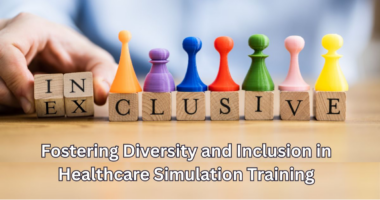 As the healthcare community increasingly prioritizes diversity, medical simulation training has been slow to catch up. Training models often lack representation in terms of diverse skin tones, ages, and body types. It’s time we tackle this issue and discover ways to create more inclusive and effective medical simulations.
As the healthcare community increasingly prioritizes diversity, medical simulation training has been slow to catch up. Training models often lack representation in terms of diverse skin tones, ages, and body types. It’s time we tackle this issue and discover ways to create more inclusive and effective medical simulations.
How is Diversity Lacking in Simulation Training?
When reviewing product offerings from major simulation technology suppliers for skin tone, age, and sex, researchers found that most full- or half-body patient simulators are young, light-skinned, and have “ideal” anatomy (think muscular, full head of hair, no obvious physical abnormalities). When darker-skinned options are available, they’re often lower in quality and tend to depict trauma, wounding, or explicit content.
The review also found limited diversity in online demonstrations of procedures using standardized or actual patients. With few exceptions, both standardized and actual patients portrayed were ideally proportioned, well-muscled, white males.
This lack of diversity can lead to unconscious biases or assumptions about certain groups, such as women, minorities, or people with disabilities. Traditionally, simulations have favored white, cisgendered, heteronormative patterns. While many health professionals lack the empathy and cultural responsiveness necessary when engaging with diverse patient populations, how can simulation (UME through CME) support the shift?
Diversity Begins in Simulation Design
Incorporating diversity, equity, and inclusion (DEI) in medical simulation programs requires a multi-faceted approach. In a study about embedding DEI into simulation programs, researchers suggested guidelines that include using diverse names, accents, and appearances and avoiding stereotyping and tokenism.
Additionally, teaming up with content experts and the target population from the beginning is key to creating authentic and inclusive simulations. Experts could be individuals from the community or representatives from organizations that serve that community.
We should conduct needs assessments and develop measurable objectives to address knowledge gaps. These objectives could include tackling social determinants of health, mistrust in medicine, LGBTQIA, and race and ethnicity-related issues.
Creating an evaluation plan that includes diversity-related components is also crucial. Actively seeking feedback from participants with lived experiences and learners from the relevant community is essential.
How to Incorporate DEI in Simulation Programs?
Common methods in simulation-based medical education include high-fidelity mannequins, virtual reality, standardized patients, task trainers, and computer-based simulations.
Compared to other approaches, simulated or standardized patients (SPs) can create realistic scenarios emphasizing various populations’ distinct needs and experiences. SPs are trained actors who portray patients with specific conditions or symptoms and can provide immediate feedback, allowing learners to improve their cultural competency skills while their memory is fresh.
For example, in a study on the use of simulations as a teaching method for health equity among emergency medicine residents, one scenario centered on affirming care, involving a young transgender patient with vaginal bleeding. The patient needs a pelvic exam but feels anxious and uneasy. The learner must use appropriate pronouns, use appropriate language when discussing organs, approach any physical exam sensitively, communicate respectfully, empathetically, professionally, and display no obvious bias.
By participating in this scenario, learners have a psychologically safe space to practice communication skills, develop empathy, and better understand the unique challenges transgender patients face. Moreover, the debriefing or feedback discussions can tackle implicit bias and demonstrate how the learner’s perceptions and stereotypes can impact their approach to patients.
Experiential learning incorporating Standardized Patients allows participants to see real-time results, which is highly motivating and encouraging while providing the opportunity for deep reflection. Simclusive offers an authentic digital simulation experience with the ease and flexibility of 1:1 self-scheduled visit at convenient times (mornings, evenings, and weekends). A person of lived experience portrays each session, followed up with a scorecard and verbal feedback with guided self-reflection to maximize behavior change. If you want to explore how to add this to your curriculum, click here to learn more.

